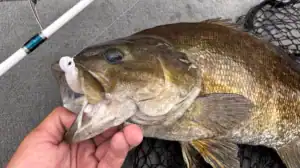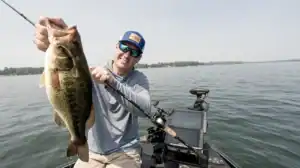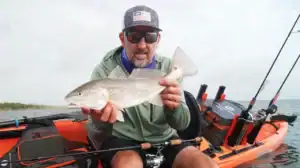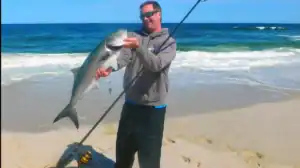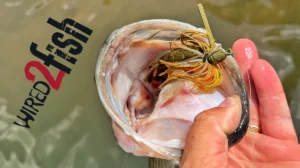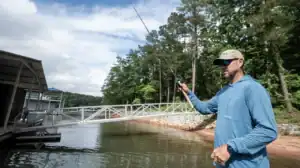Chad Green and Johnny Martin had high hopes as they headed out on a recent chilly Saturday morning for a mid-March bass tournament on Smith Mountain Lake, their home waters just southeast of Roanoke, Virginia.
The pair had been regularly weighing five-fish limits topping 25 pounds at tournaments earlier in the year, and just a couple of days before this tournament event (sponsored by the Angler’s Choice boat dealership), Green boated a 9-pound 10-ounce largemouth while pre-tournament scouting.
While they felt good about their chances of taking the tourney’s $10,000 top prize, the arrival of a cold front made things tougher, and the pair ended up with a disappointing 11th-place finish with a 17-pound bag. The next weekend, however, was magic.
Fishing a smaller event, Green and Martin brought in a five-fish bag weighing an astounding 36.88 pounds. Their limit included a 9.49-pound kicker, as well as two other fish over 7 pounds each.

“Man, what a day,” Green told Wired2Fish afterward. “There’s never been a heavier bag in Virginia.”
But there may be more, as the 62-year-old Smith Mountain Lake is pumping out more big largemouths than it has in decades. SML’s big bass boom is an example of anglers like Green and Martin literally reaping what they’ve sown.
The Angler-Led Push to Stock Smith Mountain Lake
Ten years ago, the two anglers were among a small cohort of bass fanatics who helped kickstart an innovative effort to stock SML with F1 bass, a fast-growing hybrid of Florida-strain bass and northern largemouths.
What started as a three-year pilot program supported by private fundraising has turned into a state program administered by the state Department of Wildlife Resources (DWR). Data collected by the agency shows the F1 stocking program’s impact on the lake’s big bass population isn’t simply anecdotal. The lake is clearly producing increased numbers of 5-pound-plus largemouths, and a large percentage of those big bass are proving to be F1 hybrids, which are sometimes called “tiger bass.”
Dan Wilson is the state biologist who oversees the management of Smith Mountain Lake, a 20,000-acre reservoir with more than 500 miles of shoreline. He recalled getting the first phone call from a bass fisherman asking about the possibility of starting an F1 stocking program.
“We get requests from time to time, but most of the time, they really don’t fit with what we’re trying to do management-wise,” Wilson told Wired2Fish. “Our stance has been that we don’t stock bass over healthy natural populations.”
At the time, Tennessee’s Chickamauga Lake and its big F1 hybrids were getting a lot of attention. The group of anglers looking to stock SML was willing to buy the necessary fingerling hybrids, and advances in genetic testing meant that Wilson would be able to collect hard data on how the stocked fish were doing.
“I could take a fin clip, send it to a lab, and they could tell me if it was one of our stocked fish,” he said.
So, Wilson went for it.

A Plan Comes Together
Green and Martin were among the fishermen who spearheaded the fundraising campaign, with help from others like fellow SML veteran angler Dean Wood and marina and tackle shop owner Dewayne Lamb. They raised $30,000, which was enough to buy 20,000 F1 fingerlings a year for three years from a hatchery in Alabama and to stock the lake for the same amount of time.
“We didn’t have many donors, but we had some big donors,” Green said.
Early sampling efforts focused on simply looking for those stocked fish, versus tracking growth rates.
“We were able to find our stocked fish,” Wilson said. “In a lake this size, that meant we had decent survival.”
After the first three stockings, the state took over. Since then, the DWR has stocked an average of 47,000 fingerling F1s in the lake annually. Wilson has also started focusing his data collection on studying growth.
Electrofishing the shallows is one way to collect larger fish, but not the best way, so Wilson and a crew started attending bass tournament weigh-ins. Despite tough conditions at the recent Angler’s Choice tournament, they were able to collect nearly 40 bass over 4 pounds.
“It would take us days of electrofishing to get that many bass of that size,” Wilson said.
That information has proven F1 bass are growing faster than the lake’s naturally spawned bass, and are accounting for an increasing percentage of the lake’s largemouths over 4 pounds.
In 2019, the agency tested 212 bass over 4 pounds, and found that four of them were F1s. By 2024, of the 162 bass over 4 pounds tested, 40 were F1s. That’s a jump from less than 2% to 25%.
The average weight of the biggest collected F1s also keeps climbing. In 2020, the average weight of the top 10 F1s was 5.8 pounds. In 2024, it was 7.8 pounds. Of the bass collected in 2024 that were 7 pounds or heavier, 85.7% were F1s.
While the growing use of improved technology — looking at you, forward facing sonar — may have some impact on anglers putting more 4-pound-plus bass in the boat, the data still clearly show that the lake has more of those fish 10 years into the F1 program.
“It looks like we’re achieving our goals,” Wilson said. “And it looks like a program we’d like to maintain based on the growth we’re seeing.”

Stocking Other Virginia Lakes
While Smith Mountain Lake is getting a lot of attention, the state is also stocking F1s at several other lakes, including Lake Anna in Louisa and Spotsylvania counties and Claytor Lake in Pulaski County. Results have been promising at those lakes, too.
Green certainly agrees that SML is trending in a direction he likes.
“I think I’ve caught 13 or 14 fish over 8 pounds on this lake in my life and most of them have been caught in the last few years,” he said. “Also, in my 27 years here I’d known of only two or three 10-pounders, and there have been three 10-pounders this spring already.”
More Big Bass Means Changes on Smith Mountain Lake

Is there a downside to having more big bass? Of course; fishing pressure has increased. While 2025 is a relatively light year for major tournaments at Smith Mountain Lake, there are still hundreds of smaller tournaments held here.
“The more fishing pressure there is, the harder it is for the average guy to just go out and catch fish,” Wilson said. “But we’re here to make fishing better and the simple fact is that when the fishing is better, more folks have a tendency to go there to experience it.”
Green said it’s been exciting to watch the fishery evolve, and not just because those fat F1s are helping him cash tournament checks.
“I’m out here a few days a week,” he said. “It’s been fun to have been able to see these fish grow up.”


